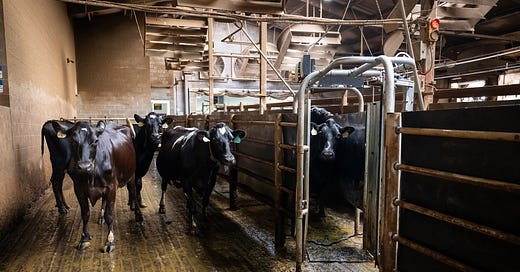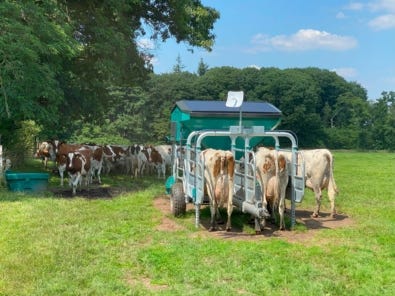Gene editing takes aim at the rumen
If you haven’t yet read this article about using gene editing to try to influence methane emissions from cows, you really should. I highly recommend it.
The article explains what’s at stake with enteric methane emissions and how researchers are on a seven-year journey to try to make lasting methane emissions change for all cows – not just those in confined animal feeding operations. The goal of the researchers would be to create a bolus treatment that could be given to calves early in life that would influence how their rumens develop. Learn more about the arch nemesis of the rumen when it comes to methane – archaea – and the potential superhero – duodenibacillus.
There is still a long way to go. While scientists have proved that they can gene-edit microbes, researchers have so far only shown that they can edit a small fraction of the microbes in the cow gut. Institute researchers are developing microbial gene-editing tools, even as they are mapping the species of the microbiome. They are building the plane while flying it.
Read the full article for free here.
Nedap launches new sort gate
Dutch-based company Nedap recently announced it will offer a new sort gate. The company says the new offering is a “modern and simplified twist on sort gate technology.” The SmartSort gate is designed for continuous cow flow. Early adopter Dave Styer, co-owner of Alfalawn Farm in Menomonie, Wisconsin, says the new gate is an improvement over existing options: “It doesn’t stop the cows like our previous sort gate, so our throughput is very good.”
Learn more about the new product here.
Lely gets into the computer vision game, announces new autonomous feed pusher
Earlier this month, Lely announced a new barn monitoring concept it is calling Zeta. The system, composed of cameras, LED lighting and minicomputers, provides comprehensive barn monitoring by tracking cows, their behaviors, mobile robots and in-barn events. The 24/7 computer vision platform uses artificial intelligence and smart algorithms to deliver data on cow health, heat detection and calving.
During the same corporate innovation event where Zeta was announced, the company also announced it will produce a new feed pusher that is truly autonomous. The new unit is equipped with a lidar laser scanner and camera to help it detect and avoid obstacles. The new pusher is designed for larger scale farms.
Learn more about these two products here.
MyAniML receives U.S. government funding
MyAniML CEO Shekhar Gupta said recently that a grant from the National Science Foundation is “proof” that his company’s cattle health company is a “dominant player” in the industry. The company claims to identify cattle health challenges in cattle through detecting changes in the animal’s muzzle.
Read more about the recent award here and more about the company here.
New feed delivery stanchion for grazing cattle
Hanskamp recently introduced the FeedStation Mobile, an automatic and individual station for the distribution of concentrate feed to cows on pasture. The new feed station can dispense two different feed types to up to four animals at a time and is mobile. It is solar-powered, smartphone-controlled and mounted on its own wheeled platform that can be towed with a tractor or four-wheel-drive vehicle. The capacity of the feeder is 60-plus bushels.
Read more here.
Study confirms benefits of synthetic pheromone for cattle
A Texas A&M University study recently published in the Journal of Animal Science confirmed that maternal bovine appeasing substance (MBAS) has several benefits for high-risk cattle during a 60-day feedlot receiving period. MBAS is the synthetic analog of a natural appeasing pheromone secreted through the skin of the mammary gland of lactating cows. The substance has been sold as FerAppease since 2022, and more than 15 million doses have been given as of 2024. Results from the new study showed that administrating the product resulted in decreased physiological stress markers in cattle.
Read more about it here.
Dairy profit projections from ZISK
Projected profitability for the next 12 months for two dairy herd sizes INCREASED in recent profit projections from ZISK.
ZISK is a profit projection smartphone app that tracks individual dairy farm profitability based on current CME board prices. Projections for a 1,000-cow dairy producing an average of 80 pounds of milk per cow and a 2,500-cow dairy producing an average of 85 pounds of milk per cow are provided.
12-month dairy farm profit projections (as of Sept. 26, 2024):
1,000-cow dairy = $1.200 million (UP about $256,000 since the middle of summer)
2,500-cow dairy = $3.829 million (UP about $687,000 since the middle of summer)









